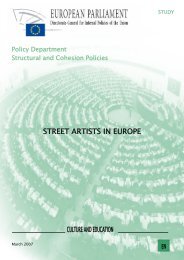MusLi (Museums Literacy) - Fondazione Fitzcarraldo
MusLi (Museums Literacy) - Fondazione Fitzcarraldo
MusLi (Museums Literacy) - Fondazione Fitzcarraldo
You also want an ePaper? Increase the reach of your titles
YUMPU automatically turns print PDFs into web optimized ePapers that Google loves.
<strong>MusLi</strong> - No qualifications needed: museums and new audiences<br />
ministrators, education officials, museum staff, prison officers, and inmates, but also medical personnel,<br />
psychologists, and prison educators and trainers at the Maison d’Arrêt de la Santé in Paris.<br />
We analyzed, qualitatively and comprehensively, the context of the project’s implementation, the<br />
adequacy and appropriateness of the content offered in regard to the unique needs of the target<br />
audience, the conditions of implementation and interactions between different project partners, the<br />
project’s overall coherence in comparison to the social and cultural missions of both institutions, and<br />
finally, the effects and benefits to those in the prison system.<br />
Methods<br />
The evaluation relied on:<br />
A review of documentation available on prisons and cultural action in prisons;<br />
A case study of cultural activities in prisons conducted by French museums;<br />
Expert interviews with legal representatives, academics, and museum professionals;<br />
71 interviews with persons in charge, coordinators, prison staff, and social and cultural stakeholders<br />
directly and indirectly involved in the program, and four group meetings with inmates who had<br />
participated in the program, and inmates who did not participate.<br />
The main results from the evaluation<br />
Compared to other artistic and cultural activities conducted in prisons, the museum as a cultural<br />
institution, presents challenges and constraints of its own:<br />
it requires actual contact between the individual and the original artwork, a very difficult task to<br />
achieve while in prison;<br />
it implies an experience of walking around the museum, an almost impossible task to achieve with<br />
regards to the restrictions imposed on inmates;<br />
finally, it requires complex knowledge and an interest for “high culture”, which are opposing prerequisites<br />
with regards to the usual profile of those detained.<br />
These elements represent major hurdles for museum activities in prison. The question of gaps in<br />
terms of artistic and cultural knowledge is reinforced by an absence or weakness of the inmates’<br />
“basic” knowledge, which for persons having a low literacy level is characterized as:<br />
difficulties in reading comprehension, understanding concepts, and an ability to abstract;<br />
significant gaps in spatial and time markers;<br />
a significant difficulty in self expression, both oral and written communication;<br />
difficulty in logical reasoning.<br />
Analysing the constraints on individuals and the prison system demonstrated the best way to translate<br />
the program’s effects on the inmate population.<br />
73






